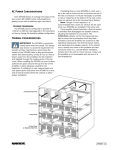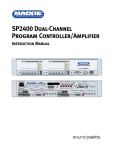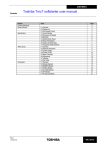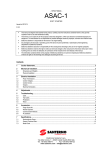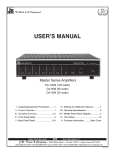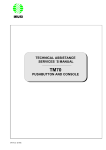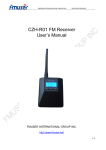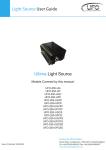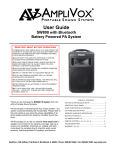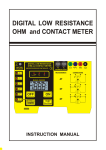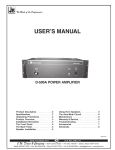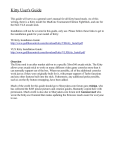Download User Manual - JW Davis & Company
Transcript
The Mark of the Professional... USER’S MANUAL DA-120M Master Series Amplifier I II III IV V VI - Unpacking/Inspection Procedures . . . . 2 - Product Features . . . . . . . . . . . . . . . . . . 2 - Product Description . . . . . . . . . . . . . . . . 3 - Back Panel Detail . . . . . . . . . . . . . . . . . . 5 - Circuit Board Level Settings . . . . . . . . . 8 - Technical Specifications . . . . . . . . . . . . 9 VII VIII IX X XI XII - PA Speaker Layout . . . . . . . . . . . . . . 10 - Polarity . . . . . . . . . . . . . . . . . . . . . . . . 12 - Power Loss in Long Lines . . . . . . . . 12 - Schematic for Input Modules 1- 4 . .13 - Schematic for Input Modules 5-6 . .14 - Schematic for Chassis Board . . . . . 15 090705122 NEW TECHNOLOGY J.W. Davis & Company OLD RELIABILITY • 3030 Canton Street • P.O. Box 710219 • Dallas, Texas 75371-0219 Sales 800-527-5705 • Fax 800-388-9106 • Corp 214-651-7341 • Fax 214-939-0328 • [email protected] • www.jwd.com The Mark of the Professional... WARNING: DO NOT CUT OR REMOVE THE GROUND PIN ON THE AC POWER CABLE. DO NOT USE AC TWO PIN ADAPTER UNLESS IT IS GROUNDED BY AN EXTERNAL GROUND WIRE. CHECK THE AC WALL RECEPTACLE TO CONFIRM THE PROPER GROUND IS PRESENT. WARNING: TO REDUCE THE RISK OF ELECTRICAL SHOCK, DO NOT REMOVE THE COVER. NO USER SERVICEABLE PARTS INSIDE. REFER SERVICING TO QUALIFIED SERVICE PERSONNEL. WARNING: TO REDUCE THE RISK OF FIRE OR ELECTRICAL SHOCK, DO NOT EXPOSE THIS UNIT TO RAIN OR MOISTURE. I - UNPACKING AND INSPECTION PROCEDURES This unit was carefully checked and packed before leaving the factory. However, the shipping container and unit should be inspected for indications of improper handling. If the unit has been damaged in transit, make an immediate claim to the carrier for their inspection. Returning the freight to J. W. Davis & Company will void your claim with the carrier. II - FEATURES The features and benefits listed below make this a unique amplifier, designed with the user’s needs in mind, to be a product that is universal and fits many applications without modifications or additional equipment. • • • • • • • • • • • • • 7 Major Application Interfaces 6 Switchable Microphone/AUX Inputs 15 Special Signal Inputs 7 Signal Outputs 120 Watts RMS Power 8-Ohm, 25 and 70 Volt System Outputs 24 VDC Alternate Power Source Multiple Music-On-Hold Options A switch to activate the 400Hz roll off circuit to protect horn drivers Tape out for recording Pre-out, Main-In for insertion of signal conditioning equipment such as equalization Booster out provides a signal for power amplifiers to expand the system FIVE-YEAR WARRANTY 2 NEW TECHNOLOGY J.W. Davis & Company OLD RELIABILITY • 3030 Canton Street • P.O. Box 710219 • Dallas, Texas 75371-0219 Sales 800-527-5705 • Fax 800-388-9106 • Corp 214-651-7341 • Fax 214-939-0328 • [email protected] • www.jwd.com The Mark of the Professional... III - DESCRIPTION The JWD Master Series of monaural amplifiers provide the combination of interface, signal control and extended mixer capacity required by professional audio system integration. In addition to traditional commercial sound applications such as paging and background music, the Master Series extends the scope of capabilities to include integration with telephone communications, audio-visual, security, sound masking and digital devices that previously have been available only in more complex modular amplifiers. All features are inclusive without requiring additional accessories or modifications. The front panel has nine controls: Six front panel volume controls (to individually control dip switchable microphone or auxiliary inputs located on the back panel), a bass and a treble control, plus a master volume control. In addition, the power switch and LED signal overload indicators are located on the front panel for easy access. The back panel contains the six microphone/auxiliary input modules matching the six front panel volume controls. All are similar to Figure 1 except for input module 5 which has two additional RCA jack inputs for CD or DVD . The first dip switch shown in Figure 1 (designated “AUX”) activates the auxiliary input. This aux input consists of two RCA jacks (marked “AUX” with an input number and “unbalanced”) that electronically combine stereo or two-channel audio for a mono signal. To input a single mono signal, either RCA jack may be used. The second dip switch (designated “T”) activates the phoenixtype microphone input. Do not use the XLR connector at the same time, as this will degrade the signal. The third dip switch (designated “J”) activates the microphone XLR input. Do not use the phoenix-type microphone input at the same time as this will degrade the signal. Figure 1 The fourth dip switch (designated “Phantom”) activates the phantom power needed for condenser microphones. If the phantom power is left on, it will not harm the dynamic microphones but should be turned off for safety measures when not in use. Three additional dedicated inputs with volume controls are located on the back panel. (The Master Volume Control or the Bass and Treble Controls do not affect the following three inputs.) (1) Telephone Page input that accepts the signal directly from the page port out on the telephone system. (2) Music-On-Hold (built in) one-watt amplifier that provides music and information to the telephone hold system. The same infromation may be routed to the main amplifier for distribution to the entire sound system via input 5. (3) System OverRide (“SOR”) input default setting is for sound masking. This input is not affected by the tone controls or any other function of the amplifier. The sound masking may be equalized before using the other amplifier functions. However, the input also may be changed by a jumper on the circuit board to become a priority input for the system. 3 NEW TECHNOLOGY J.W. Davis & Company OLD RELIABILITY • 3030 Canton Street • P.O. Box 710219 • Dallas, Texas 75371-0219 Sales 800-527-5705 • Fax 800-388-9106 • Corp 214-651-7341 • Fax 214-939-0328 • [email protected] • www.jwd.com The Mark of the Professional... A separate, internal, 1-watt amplifier is used to provide the music-on-hold functions which permits close control of volume levels. The music-on-hold RCA-type input shown in Figure 2 allows the signal from music, tape messages, company advertisements or other sources to feed the music-on-hold amplifier. The output also may be routed to include the main amplifier for general distribution using the switch in Figure 2. Paging with VOX muting may be accomplished either from microphone one input or through the telephone input, a feature desirable in installations such as hospitals, airports and auto dealerships where paging may be required from multiple locations. Figure 2 A wide range of background music and audio/visual programming applications are supported through the CD/DVD input and the six AUX inputs. For applications requiring recording of program material, a special tape-out jack is available. Applications such as priority signaling and sound masking that must not be interrupted by the regular functions of the amplifier are possible through the dedicated System OverRide input control that is independent of the master, bass or treble controls. An equalizer or other signal modifying devices may be easily inserted by an external pre-amp, inputoutput jack. An external dip switch for phantom power eliminates the need to remove cover. Installation expansion requiring greater power is accomplished through a booster output jack which allows the signal from the DA-120M to be connected to the input of an additional amplifier. A master volume control is provided for overall control of the microphone and auxiliary outputs. Bass and treble controls permit adjustment of voice and music output. Paging horn protection from damage against overdriving the lower frequencies is provided by 400Hz high pass filter. VOX muting is available for MIC 1 and System OverRide by activation at the board level. The DA-120M may be rack or wall mounted using optional accessory kit RAK-120A/M, or WM-120M. NOTE: If the Amplifier is frequently moved to different locations, or used as a portable system, the XLR connectors should be used. The action of plugging and unplugging the connector maintains a good connection. If the amplifier is installed in a permanet location, the phoenix-type screw terminals should be used for a better long-term connection. 4 NEW TECHNOLOGY J.W. Davis & Company OLD RELIABILITY • 3030 Canton Street • P.O. Box 710219 • Dallas, Texas 75371-0219 Sales 800-527-5705 • Fax 800-388-9106 • Corp 214-651-7341 • Fax 214-939-0328 • [email protected] • www.jwd.com The Mark of the Professional... IV - BACK PANEL DETAIL INPUT 4 (1) Input 4 XLR input jack accepts balanced low impedance signal from microphones, mixers, wireless microphone receivers and equipment with compatible signals. The input is rated at 150Ω, 1mV. (2) Input 4 terminal strip input accepts balanced low Impedance signal from microphones, mixers, wireless microphone receivers and equipment with compatible signals. The input is rated at 150Ω, 1mV. (3) Input 4 dip switch allows four selections: auxillary (AUX), screw terminal (T), XLR-F (J) and 17VDC phantom power (PHANTOM). NOTE: Only one input (4) Input 4 features two RCA jacks that electronically combine stereo or twoon the dip switch (Microchannel audio into a mono signal. To input a single mono signal, either RCA phone XLR, Microphone jack may be used. The input is rated at 47kΩ at 100mV. Screw Terminal or AuxilINPUT 3 iary) should be selected at any given time. Se(5) Input 3 features two RCA jacks that electronically combine stereo or twolecting more than one channel audio for a mono signal. To input a single mono signal, either RCA input will cause a distorjack may be used. The input is rated at 47kΩ at 100mV. tion and a drop in the in(6) Input 3 dip switch allows four selections: auxillary (AUX), screw terminal (T), put signal. XLR-F (J) and 17VDC phantom power (PHANTOM). (7) Input 3 terminal strip input accepts balanced low impedance signal from microphones, mixers, wireless microphone receivers and equipment with compatible signals. The input is rated at 150Ω, 1mV. (8) Input 3 XLR input jack accepts balanced low impedance signal from microphones, mixers, wireless microphone receivers and equipment with compatible signals. The input is rated at 150Ω, 1mV. INPUT 2 (9) Input 2 XLR input jack accepts balanced low impedance signal from microphones, mixers, wireless microphone receivers and equipment with compatible signals. The input is rated at 150Ω, 1mV. (10) Input 2 terminal strip input accepts balanced low impedance signal from microphones, mixers, wireless microphone receivers and equipment with compatible signals. The input is rated at 150Ω, 1mV. (11) Input 2 dip switch allows four selections: auxillary (AUX), screw terminal (T), XLR-F (J) and 17VDC phantom power (PHANTOM). (12) Input 2 features two RCA jacks that electronically combine stereo or two-channel audio into a mono signal. To input a single mono signal, either RCA jack may be used. The input is rated at 47kΩ at 100mV. 5 NEW TECHNOLOGY J.W. Davis & Company OLD RELIABILITY • 3030 Canton Street • P.O. Box 710219 • Dallas, Texas 75371-0219 Sales 800-527-5705 • Fax 800-388-9106 • Corp 214-651-7341 • Fax 214-939-0328 • [email protected] • www.jwd.com The Mark of the Professional... INPUT 1 (13) Input 1 features two RCA jacks that electronically combine stereo or two-channel audio into a mono signal. To input a single mono signal, either RCA jack may be used. The input is rated at 47kΩ at 100mV. (14) Input 1 dip switch allows four selections: auxillary (AUX), screw terminal (T), XLR-F (J) and 17VDC phantom power (PHANTOM). (15) Input 1 terminal strip input accepts balanced low impedance signal from microphones, mixers, wireless microphone receivers and equipment with compatible signals. The input is rated at 150Ω, 1mV. (16) Input 1 XLR input jack accepts balanced low impedance signal from microphones, mixers, wireless microphone receivers and equipment with compatible signals. The input is rated at 150Ω, 1mV. INPUT 5 (17) Input 5 XLR input jack accepts balanced low impedance signal from microphones, mixers, wireless microphone receivers and equipment with compatible signals. The input is rated at 150Ω, 1mV. (18) Input 5 terminal strip input accepts balanced low impedance signal from microphones, mixers, wireless microphone receivers and equipment with compatible signals. The input is rated at 150Ω, 1mV. (19) Input 5 dip switch allows four selections: auxillary (AUX), screw terminal (T), XLR-F (J) and 17VDC phantom power (PHANTOM). (20) Input 5 features two RCA jacks that electronically combine stereo or two-channel audio into a mono signal. To input a single mono signal, either RCA jack may be used. The input is rated at 47kΩ at 100mV. NOTE: If the Music-On-Hold is switched to main amp, no other inputs on Aux 5 can be used. The controls for Input 5 on the front will apply. The MOH output will remain controlled by the volume control located at the MOH input. (21) Input 5 has an additional input for DVD or CD. The input is rated at 47kΩ, 360mV. INPUT 6 (22) Input 6 features two RCA jacks that electronically combine stereo or two-channel audio into a mono signal. To input a single mono signal, either RCA jack may be used. The input is rated at 47kΩ at 100mV. (23) Input 6 dip switch allows four selections: auxillary (AUX), screw terminal (T), XLR-F (J) and 17VDC phantom power (PHANTOM). (24) Input 6 terminal strip input accepts balanced low impedance signal from microphones, mixers, wireless microphone receivers and equipment with compatible signals. The input is rated at 150Ω, 1mV. (25) Input 6 XLR input jack accepts balanced low impedance signal from microphones, mixers, wireless microphone receivers and equipment with compatible signals. The input is rated at 150Ω, 1mV. 6 NEW TECHNOLOGY J.W. Davis & Company OLD RELIABILITY • 3030 Canton Street • P.O. Box 710219 • Dallas, Texas 75371-0219 Sales 800-527-5705 • Fax 800-388-9106 • Corp 214-651-7341 • Fax 214-939-0328 • [email protected] • www.jwd.com The Mark of the Professional... (26) Pre Out/Power In. The two RCA jacks offers an opening between the pre amp and the power section of the amplifier. This allows the insertion of an equalizer or other signal conditioning equipment. Unbalanced. (27) Tape Recording Output, Unbalanced. 1 Volt , 600Ω. (28) Booster Out, Unbalanced. 1 Volt, 600Ω. (29) Telephone Page Volume Control. Controls the page volume and is unaffected by the other controls. (30) Telephone Page Input. The transformer coupled telephone input terminals will accept a balanced (3-Wire) or unbalanced (2-Wire) line direct from the telephone page port out (talk battery without ring). VOX muting of inputs 1-6 during page. G=Sleeve, COM=Ring, HOT=Tip. Transformer Balanced 600Ω. (31) Music-On-Hold Output. Music, commercials or other information may be fed to the telephone system and to the main amplifier if desired. 600Ω, 1 Volt (adjustable). (32) Music-On-Hold Volume Control. Controls the volume of the MOH output and is unaffected by the other controls. (33) Switch Music-On-Hold to Main Amp. The switch allows the same information on the MOH input to be used by the Main Amplifier. NOTE: No other inputs on Aux 5 can be used. The controls for Input 5 on the front will apply. The MOH output will remain controlled by the volume control located at the MOH input. (34) Music-On-Hold Input RCA Connector. Input for music, commercials or other information. 47kΩ, 100mV. (35) System OverRide (“SOR”) Connector. Input for sound masking. (The input may be changed by a jumper on the circuit board to become a priority input for the system.) The SOR input is not affected by the tone controls, master volume control or any other function of the amplifier. The sound masking may be set up and equalized before the other functions of the amplifier are used. Unbalanced 47k Ω, 100mV. (36) System OverRide Volume Control. Controls the volume of System OverRide output of the amplifier. (37) High Pass Filter Switch. When the switch is in the ON position, the output signal will roll off frequencies of 400Hz and below. Eliminating the lower frequencies will help prevent damage to the voice coil (diaphram) of horns. (38) Receptacle for 115V Power Cable. Built-in 5A, 250V Replaceable Fuse. (39) Chassis Ground Terminal. (40) 24VDC Power Input. The 24 VDC allows the amplifier to be used with emergency backup power supplies, portable use or where 115VAC is not available. (41) Speaker Output Terminals. The available screw terminal outputs are 8Ω, 25V or 70V. Only one output should be used at a time. 7 NEW TECHNOLOGY J.W. Davis & Company OLD RELIABILITY • 3030 Canton Street • P.O. Box 710219 • Dallas, Texas 75371-0219 Sales 800-527-5705 • Fax 800-388-9106 • Corp 214-651-7341 • Fax 214-939-0328 • [email protected] • www.jwd.com The Mark of the Professional... VI - CIRCUIT BOARD LEVEL SETTINGS FOR ADDITIONAL FEATURES WARNING: The following changes should be made only by a qualified technician to avoid the risk of electrical shock and of voiding the warranty due to improper circuit wiring. ACTIVATION OF TELEPHONE VOX MUTING The default setting of the DA-120M is shipped from the factory with the telephone VOX mute activated and will mute the six MIC/AUX inputs. ACTIVATION OF MICROPHONE 1 VOX MUTING To give microphone 1 precedence over microphones 2 - 6, change the jumper #JP-205 to the ON position and jumper #JP-203 to the OFF (Mute MIC One) position. These jumpers are located on the rear of the lower circuit board for easy access (Figure 3). This feature is especially useful where a conference chairman, a podium speaker, a dispatcher or other speaker may require primary access Figure 3 to the system. ACTIVATION OF THE SYSTEM OVERRIDE INPUT TO BECOME A PRIORITY INPUT The default setting of the System OverRide is for sound masking applications. Jumper #JP-301 (Figure 4) will allow the Signal OverRide to become a priority input and mute all inputs except the Music-On-Hold to the telephone system. The jumper is located on the upper circuit board, close to the SOR input. Figure 4 8 NEW TECHNOLOGY J.W. Davis & Company OLD RELIABILITY • 3030 Canton Street • P.O. Box 710219 • Dallas, Texas 75371-0219 Sales 800-527-5705 • Fax 800-388-9106 • Corp 214-651-7341 • Fax 214-939-0328 • [email protected] • www.jwd.com The Mark of the Professional... VI - TECHNICAL SPECIFICATIONS Model Power Rating Frequency Response S/N Ratio (tone controls flat) THD Balanced Balanced Unbalanced Inputs Unbalanced Unbalanced Unbalanced Balanced Unbalanced Microphone Phantom Power DA-120M 120 Watts Continous ±3dB 60Hz - 15kHz Tel: ±3dB 250Hz - 15kHz Mic: >60dB Telephone: >60dB Aux: >75dB CD/DVD: >75dB MOH: >75dB SOR: >75dB <1% Mic XLR (6): 150 Ohm, 1mV Mic Terminal (6): 150 Ohm, 1mV Aux (6): Electronically-Summed., 47k Ohm, 100mV DVD/CD: Electronically-Summed., 47k Ohm, 360mV MOH: 47k Ohm, 100mV SOR: 47k Ohm, 100mV Tel: Transformer-Balanced, 600 Ohm, 100mV Power-In: 47k Ohm, 1 V (6) 17 VDC Dip-Switchable Speaker: 8 Ohm, or Transformer/Speaker: 25 V (5.2 Ohm), or 70.7 V (42 Ohm) MOH: 600 Ohm, 0 ~ 1 V (adjustable) Outputs Tape Out: 600 Ohm, 1 Volt Booster Out: 600 Ohm, 1 Volt Pre-Out: 600 Ohm, 1 Volt Unbalanced Unbalanced Unbalanced Power Consumption Thermal Control Dimensions Telephone VOX: -37dB Mic 1 VOX: -37dB (Via Jumper #205/203) SOR VOX: -37dB (Via Jumper #301) Bass: 100Hz >=± 10dB Treble: 10kHz >=± 10dB 400Hz, -6dB/Octave Power On, Multi-Colored LED Output Meter 115VAC 24VDC 360VA 3” Thermally Controlled Variable Speed Fan 17" W x 12" D x 3.5" H Weight 19.8 lbs. Shipping Weight Accessories Accessories 23.5 lbs. RAK-120A/M Rack Mount Kit WM-120M Wall Mount Kit Mute Circuits Tone Controls High Pass Filter (switchable) Indicator’s Power Source 9 NEW TECHNOLOGY J.W. Davis & Company OLD RELIABILITY • 3030 Canton Street • P.O. Box 710219 • Dallas, Texas 75371-0219 Sales 800-527-5705 • Fax 800-388-9106 • Corp 214-651-7341 • Fax 214-939-0328 • [email protected] • www.jwd.com The Mark of the Professional... XII - CONSIDERATIONS FOR PA SPEAKER LAYOUT SPEAKER CONNECTIONS In connecting speakers to a public address amplifier, it is important to present the amplifier with the load impedance it is designed to handle. Failure to do this can cause overheating and component failure. In many cases problems can take months to appear in the form of reduced intelligibility and unnecessary service calls. A load impedance that is too low is especially bad. Strive to have a load impedance of not less than 80% of the chosen amplifier output impedance. Do not connect a 4-ohm speaker to the 8-ohm output. Driving a load of higher impedance than rated amplifier output is not as serious, but results in a power loss proportional to the mismatch and should be avoided. For example, driving a 16-ohm load through the 8-ohm output will result in a 50% loss in power. The high impedance mismatch should be kept to less than 200%, especially if it is anticipated that more than 50% of the rated amplifier power will be required. There are two methods of connecting groups of speakers to the amplifier. First, using low impedance (i.e. 4, 8, 16 ohm) outputs. This is preferable where: (a) Runs are short (less than 200 ft. (70 m)) (b) Few horns or speakers are to be used (ie. typically 4-8) (c) Same sound levels are required at each speaker (d) Low impedance also provides slightly better fidelity and frequency response. High impedance or constant voltage is the second method, and is preferable where: (a) The runs are long and line losses are to be avoided (b) Many speakers are to be used (c) Different sound levels are required at different locations; for example, indoor speakers and outdoor horns (d) Future expansion possibilities require flexibility in wiring layout. The following is a more detailed discussion of these two methods. LOW IMPEDANCE CONNECTION The speakers must be connected to present a combined impedance equal to the selected amplifier output impedance; i.e., 4, 8, 16 ohms. The connections should be arranged in a series/parallel combination to achieve this according to the following formula. The impedance should be between 70% and 200% of the output impedance selected. If the amplifier is to be driven anywhere near its full rated output the impedance should be well within these tolerances. SERIES/PARALLEL COMBINATIONS In larger systems it will be necessary to combine series and parallel connections to obtain the necessary impedance. The rule for calculating the total effective impedance is to divide the entire circuit into individual small series of parallel sub-circuits and apply the foregoing rules to them. 10 NEW TECHNOLOGY J.W. Davis & Company OLD RELIABILITY • 3030 Canton Street • P.O. Box 710219 • Dallas, Texas 75371-0219 Sales 800-527-5705 • Fax 800-388-9106 • Corp 214-651-7341 • Fax 214-939-0328 • [email protected] • www.jwd.com The Mark of the Professional... The following is an example using 16 8-Ohm speakers. Each schematic is an impedance equivalent to its predecessor but has been simplified. A problem arises if one more speaker must be added at some future date, as all the connections must be changed. This is not a significant problem if only a few speakers are involved. But if the network is extensive, the problem will be magnified. Futhermore, failure of one speaker can take out a number of associated units. HIGH IMPEDANCE OF CONSTANT VOLTAGE (25 AND 70v) SYSTEMS The high impedance or constant voltage method of impedance matching uses a high impedance amplifier output which is transformed down to 8 Ohms by an impedance matching transformer at each individual speaker. The big advantages of this approach as compared to low impedance are: (1) Reduced line losses and ability to use smaller wire gauges. This is due to the higher voltage and reduced current in the speaker lines. (2) Much simpler impedance matching procedures and connections. Constant voltage is a misnomer in that the amplifier does not always produce 70V. Rather, the amplifier output impedance is set at such a level that, irrespective of its rated power, it will produce70.7 Volts output at full power. Thus a 10 Watt amplifier optimum load would have an impedance of 500 Ohms (P = 70.7²/500), a 40-Watt amp would be 126 Ohms and 120-Watt amp, 42 Ohms. Multiple transformer taps allow the impedance at each speaker to be adjusted individually to give a total matched load. Because of the high impedance arrangement, the system is easier to impedance match and is also inherently less susceptible to problems caused by mismatching. The transformer taps are marked in W=watts instead of Ohms (usually 4, 2, 1, ¹⁄₂). Again, it should be born in mind that these levels of power output are only achieved when the transformer is working at 70.7 Volts. The transformers are connected in parallel. A good match is obtained by ensuring that the total of all tap settings fits into the range of 40-80% of rated amplifier output. 80% is chosen to allow for transformer insertion loss. Also, It is good practice not to drive the amplifier to 100% of its capacity. Examples are shown below. For simplicity, it is assumed that all tap settings are the same at each speaker. For a 120-Watt amplifier, the range 40-80% is equivalent to 48-96 Watts. Therefore: 18 12 60 60 90 speakers x 4 Watt taps each = 72W . . . . . . . . . . . Good match speakers x 1 Watt taps each = 12W . . . . . . . . . . . Poor match speakers x 1 Watt taps each = 60W . . . . . . . . . . . Good match speakers x 4 Watt taps each = 240W . . . . . . . . . . Very poor match - overload speakers x 1 Watt taps each = 90W . . . . . . . . . . . Good match NOTE: None of the above tap settings guarantee the actual sound levels through each speaker. This is a function of the master volume control as well as the tap setting. The tap setting simply defines the maximum power consumed by an 8-Ohm speaker if presented with 70.7 Volt input. In systems with a small number of speakers, it is always preferable to use a high tap setting and reduce the sound level by turning down the master volume control. In calculating the amplifier rating needed for a typical music/ paging system using speakers distributed to an office environment, a good rule of thumb is to allow about one watt per speaker and space speakers at 1¹⁄₂ x ceiling height. For noisy areas, or where the volume level required is higher, more power is required. 11 NEW TECHNOLOGY J.W. Davis & Company OLD RELIABILITY • 3030 Canton Street • P.O. Box 710219 • Dallas, Texas 75371-0219 Sales 800-527-5705 • Fax 800-388-9106 • Corp 214-651-7341 • Fax 214-939-0328 • [email protected] • www.jwd.com The Mark of the Professional... VIII - POLARITY When using multiple speakers in a sound system installation, one must observe proper polarity of the speakers in order to prevent the cancellation effects caused by adjacent speakers being in reverse polarity. Speakers in reverse polarity will lose much of their normal volume and produce poor tonal quality. For speakers facing in the same general direction, all speaker cones should move in unison in the same direction. When two speakers face each other, the cone of one speaker should more inward when the other speaker cone moves outward. All JWD speakers have the “hot” terminal marked with a “+” or a red dot. The “common” terminal is either unmarked or marked with a “-”. Positive voltage applied to the “+” terminal will result in a forward or outward movement of the speaker cone. If using speakers which are unmarked, or using speakers from various manufacturers, the following procedure will provide a fast and simple test for polarity. 1. Connect one side of a 9-Volt battery to one speaker terminal. 2. Momentarily connect the other side fo the battery to the other speaker terminal. 3. Note the direction of the cone movement (inward or outward). If the cone movement is inward (backward), reverse the battery leads. 4. Mark the speaker terminal connected to the positive side fo the battery as positive “+”. 5. Repeat the procedure for each successive speaker to ensure that the cone movement is forward (outward) in each case. XIX - POWER LOSS IN LONG LINES For long lines, the power loss in watts becomes a significant factor. The power supplied by the amplifier is effectively reduced by the line loss. For a 0.5 dB loss in sound pressure the total wire resistance must be limited to 6% of speaker impedance. The table below shows the calculated two-wire cable lengths permissible for a number of wire sizes in feet. For a 1 dB loss, the lengths may be doubled. For 2 dB loss, multiply by 4.4. 12 NEW TECHNOLOGY J.W. Davis & Company OLD RELIABILITY • 3030 Canton Street • P.O. Box 710219 • Dallas, Texas 75371-0219 Sales 800-527-5705 • Fax 800-388-9106 • Corp 214-651-7341 • Fax 214-939-0328 • [email protected] • www.jwd.com X - SCHEMATIC FOR INPUT MODULES 1-4 The Mark of the Professional... 13 NEW TECHNOLOGY OLD RELIABILITY J.W. Davis & Company • 3030 Canton Street • P.O. Box 710219 • Dallas, Texas 75371-0219 Sales 800-527-5705 • Fax 800-388-9106 • Corp 214-651-7341 • Fax 214-939-0328 • [email protected] • www.jwd.com XI - SCHEMATIC FOR INPUT MODULES 5-6 The Mark of the Professional... 14 NEW TECHNOLOGY OLD RELIABILITY J.W. Davis & Company • 3030 Canton Street • P.O. Box 710219 • Dallas, Texas 75371-0219 Sales 800-527-5705 • Fax 800-388-9106 • Corp 214-651-7341 • Fax 214-939-0328 • [email protected] • www.jwd.com XII - SCHEMATIC FOR CHASSIS BOARD The Mark of the Professional... 15 NEW TECHNOLOGY OLD RELIABILITY J.W. Davis & Company • 3030 Canton Street • P.O. Box 710219 • Dallas, Texas 75371-0219 Sales 800-527-5705 • Fax 800-388-9106 • Corp 214-651-7341 • Fax 214-939-0328 • [email protected] • www.jwd.com The Mark of the Professional... DA-120M Master Series Amplifier Please Note: Thank you for selecting a J. W. Davis DA-120M Amplifier. Since 1933 it has been our goal to produce a complete line of quality products and to offer a FIVE YEAR WARRANTY on most J. W. Davis items. We also promise that you or your customer will not see our products listed in a discount catalog. You may sell J. W. Davis & Company products with confidence and pride. For your next installation please consider the other fine J. W. Davis products such as power amplifiers, pre-Amplifiers, mixers, microphones, speakers, speaker systems, horns, lecterns, baffles, transformers, volume controls, and accessories. Also, be sure to check our web site (www.jwd.com) for additional manufacturers’ products that we distribute. PURCHASE INFORMATION FOR YOUR RECORDS: DA-120M SERIAL # PURCHASE DATE INSTALLATION DATE PURCHASED FROM ADDRESS CITY & STATE TELEPHONE # NAME NEW TECHNOLOGY J.W. Davis & Company OLD RELIABILITY • 3030 Canton Street • P.O. Box 710219 • Dallas, Texas 75371-0219 Sales 800-527-5705 • Fax 800-388-9106 • Corp 214-651-7341 • Fax 214-939-0328 • [email protected] • www.jwd.com
















